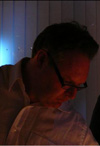December 2006
Winter
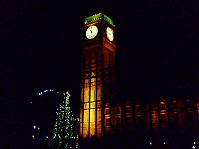 Suddenly it's Christmas. It is dark for 16 hours of every day, and we are considered lucky that it hasn't snowed. Finally
the tradition of soaking a round pudding in brandy and setting it alight (an effigy of the sun) makes sense. As does
Christmas dinner (stodgy winter fare, which seemed irrational in New Zealand in mid-summer), yule logs and all the
other pagan trappings. In fact, if it took a human sacrifice just to get the sun to come back, a number of people I know
would probably have been game to try.
Suddenly it's Christmas. It is dark for 16 hours of every day, and we are considered lucky that it hasn't snowed. Finally
the tradition of soaking a round pudding in brandy and setting it alight (an effigy of the sun) makes sense. As does
Christmas dinner (stodgy winter fare, which seemed irrational in New Zealand in mid-summer), yule logs and all the
other pagan trappings. In fact, if it took a human sacrifice just to get the sun to come back, a number of people I know
would probably have been game to try.
Mind you, London in winter at night is lovely - as witness this image of Big Ben, with the London Eye in the background and
Christmas tree in the foreground.
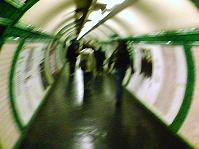 Have I mentioned the tube? London, it turns out, is hollow. There are several hundred miles of tunnels under the city
filled with thundering trains. When they stop, people pour on and off. Some trains have people packed in like sardines.
As the train pulls into the station, people are reminded to stand behind the yellow line at the edge of the platform.
However, doing this decreases the chance of getting a seat on the train that has just pulled up. So, like penguins crowding
the edge of the ice to see if there are any sealions about, the commuters all push forward in a crush. Occasionally one
falls in. To be fair, the person concerned, completely sick of London the weather and their fellow commuters, often jumps of
their own volition.
Have I mentioned the tube? London, it turns out, is hollow. There are several hundred miles of tunnels under the city
filled with thundering trains. When they stop, people pour on and off. Some trains have people packed in like sardines.
As the train pulls into the station, people are reminded to stand behind the yellow line at the edge of the platform.
However, doing this decreases the chance of getting a seat on the train that has just pulled up. So, like penguins crowding
the edge of the ice to see if there are any sealions about, the commuters all push forward in a crush. Occasionally one
falls in. To be fair, the person concerned, completely sick of London the weather and their fellow commuters, often jumps of
their own volition.
 Perhaps more interesting are the miles of tunnels at each station that lead from one platform to the next (pictured).
These can be very extensive, and in fact today I got off at the Monument Tube Station and walked down a few, and ended up
inside the Bank Tube Station, suggesting some of these tunnels go for miles underground.
Perhaps more interesting are the miles of tunnels at each station that lead from one platform to the next (pictured).
These can be very extensive, and in fact today I got off at the Monument Tube Station and walked down a few, and ended up
inside the Bank Tube Station, suggesting some of these tunnels go for miles underground.
I also got to Kew Gardens, and this crow (Or is a rook? A raven? What's the difference?) is from there, surveying Kew from
the bare branches of a tree in winter.
Comment
Top
November 2006
London
 So now I'm working for "Auntie" - Britain's wise and trusted maiden aunt - the BBC. And I find it is the same as working at
any other IT job, except there is a Dalek in the tea room.
So now I'm working for "Auntie" - Britain's wise and trusted maiden aunt - the BBC. And I find it is the same as working at
any other IT job, except there is a Dalek in the tea room.
London is an extraordinary city. It covers the area of Auckland but has 7 million residents, a number that swells to 14
million during the working day. The streets are very congested and the underground, while efficient at moving millions of
people a day, is not very fast. Consequently it takes 60 minutes to reach anywhere - this is known as the 60 minute rule.
However I have a secret weapon - I plan to buy a bicycle.
I arived in autumn, just in time to see leaf fall (see picture) whereupon the sun disappeared - it gets dark at four in the
afternoon, and when the sun is up, it is obscured by 100% overcast.
Comment
Top
October 2006
Singapore
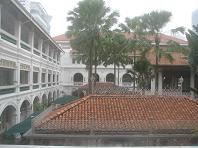 October flew by. My house was packed up, possessions stored, house rented, and I set out for London. First stop was Melbourne
where I was saying in the Rialto on Collins, and had dinner with friends. Then more friends took me out for cocktails, ending
up at Fidel's Cigar Bar - which is very trendy (you could spend AUD$600 on a glass of 1949 Macallans whiskey if you so chose).
October flew by. My house was packed up, possessions stored, house rented, and I set out for London. First stop was Melbourne
where I was saying in the Rialto on Collins, and had dinner with friends. Then more friends took me out for cocktails, ending
up at Fidel's Cigar Bar - which is very trendy (you could spend AUD$600 on a glass of 1949 Macallans whiskey if you so chose).
Next was Singapore - arriving at 2 am in 100% humidity and 28 degrees Celsius weather. The next day it was off to Raffles Hotel
(Pictured) for a Singapore Sling - very refreshing. The fogginess in the picture is real - Singpore was under a cloud of smoke
generated by fires in Indonesia. The Raffles museum contained lots of signed pictures by famous writers who had stayed there,
and clippings from the Straits Times 1902 and 1903:
A Tiger in Town
Shot at Raffles Hotel
Under the Billiard Room
And:
Python at Raffles
The Famous Tiger Hunt Recalled by a Snake Capture
It was not a Product of the Bar
Of course, Singapore is famous for being lost to the Japanese in WWII, and so I journeyed up Government Hill to Fort Canning and
a display called the "Battle Bunker". Government Hill has a spice garden, with nutmeg trees, and cicadas that whistle. There
is also a cemetary, with many graves of colonials, notably many children - reminding us that child mortality was very high in the
19th and early 20th century. I also came across a sign banning cyclists from cycling through an underpass (fine S$1000) and the
Canning Reservoir is protected by a chain link fence that has lurid signs showing soldiers arresting trespassers at bayonet point.
The Battle Box was General Percival's command bunker (Percival famously was in command when Singapore fell - and a whole British
Corps surrendered). The interior has a sound and light show and lots of tableaus with wax figures of people standing over maps
and such.
Singapore shows signs of being well defended against the monsoon - large deep drains are everywhere, and even flat lawns have
concrete vents leading to drains in them. The footpaths are slotted slabs of cement, and visible below the footpath is a drain.
With all these drains, an actual monsoon must clearly be an awesome experience. After this is it was a trip back to my room to
play a simulation (boardgame) of the invasion of Malaysia.
Next it was on a plane to Dubai (flew over the Palm Islands) and then on to London. In so doing we flew over the Persian Gulf, and
then Iran. We followed the Iran / Iraq border closely, as if not wanting to get too far into Iranian airspace. Emirates flights
do not go over either Iraq or Israel. The flight was then over Syria, Turkey, the Black Sea and then Rumania to the Carpathians.
The Czech Republic, Austria (we flew directly over Linz) and Vienna (where the clouds parted and the city and the Danube were visible).
Finally over Germany (there was a wind farm visible near Aachen), Belgium and then England. I arrived on my friend's doorstep after
35 hours continuous travel, and waited for them in the rain until they arrived home from work.
Comment
Top
September 2006
Make war on stuff!
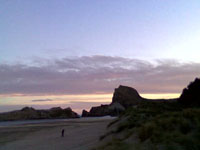 September has been a big month. I am moving to London, and now face the dilemma of what to take with me, what to
store, and what to throw away. Why are we so addicted to stuff? I have absolute piles of stuff I don't know what to
do with.
September has been a big month. I am moving to London, and now face the dilemma of what to take with me, what to
store, and what to throw away. Why are we so addicted to stuff? I have absolute piles of stuff I don't know what to
do with.
I can think of two reasons:
First, people tell us we need it. I get tons (literally) of junk mail. Like everybody else I throw it away, but
being the time efficient person I am, I am aware of the time lost in handling this stuff. Junk mail is the spam of
the real world. Along with television advertising - Ugh! As Hitler once said: "Repeat a lie often enough and it
becomes accepted as truth." This is the basis of propaganda. And that is what junk mail and high rotate
television advertising is. Capitalist propaganda. So we get told our lives will be better if we eat this junk food,
or buy that Guthrey Renker torture device. And we end up working 60 hour weeks to get enough money to buy all this
crap. It's all baloney!
Second. Bragging rights. Recent talk at work has been around immortality - so I fished out my old biochemistry
texts. Then we talked about comic books - So I fished out my old comics. Conversations on military technology
produced old gaming magazines, and famous battles caused the unearthing of armies of toy soldiers.
And we all know the theory of the babe-magnet automobile (also known as the midlife crisis red sportscar, the penis
extension etc). I saw some holiday snaps of Italy taken my friends. In medieval Italy as a family became rich, they
would erect a tower. Apparently their cities became full of towers, with people firing arrows from one to the
other (I guess this would be a medieval precursor to litigation). But when the head of the family lost their
fortune, they had to remove the tower - detumesce as it were. So having junk is about sexual competition? How
sad is that?
I recently read an excellent book called
The Paradox of Choice: Why More Is Less
by Barry Schwartz. It his thesis that when we have a few choices, it is good, but when we get too many, then it
becomes stressful and upsetting. According to Schwartz, people hate losing more than they enjoy winning. And if
given a range of choices, the unpicked ones register as losses ("What would have happened if I had..."). So as
choices go up, satisfaction goes down. This is true for video players ("We have 20 more features than our nearest
competitor") and dating sites ("I want the perfect mate, and this one is great, but if I stay online longer I MIGHT
find someone better"). In short, we are spoilt for choice. Literally.
Well, other than obsessing about the evils of capitalism, I have been building wargaming terrain, and looking at
real estate in the Wairarapa (see above sunset picture of Castlepoint). So this is all about bragging rights and
attracting mates? I guess we will just have to see if I build a flashy nest at Mataikona. Indoor-outdoor
flow grass-stems anyone? What about this bower full of shiney trinkets I just made? Oh dear. I think we are all
doomed...
Comment
Top
August 2006
Invading Germany (again)
 August marked the arrival of Call to Arms 2006. I took part in a demonstration game of
Modern Spearhead
featuring a Soviet invasion of West Germany and the encirclement of Hannover. Defenders were the British Army on
the Rhine (BAOR). While this battle never took place in real life, it was a major fear of NATO during the Cold
War. The battle was a tenative Soviet victory. In previous years we have fought a Soviet river crossing at
Alsfeld
(Soviet victory) and a Soviet invasion through the
Fulda Gap (Soviet victory). All things
being equal, it is probably just as well the Warsaw Pact never tried this for real, as our results suggest it
might have been hard to stop them. Pictured is the Soviet crossing of the Weser River near Holzminden, south of
Hannover.
August marked the arrival of Call to Arms 2006. I took part in a demonstration game of
Modern Spearhead
featuring a Soviet invasion of West Germany and the encirclement of Hannover. Defenders were the British Army on
the Rhine (BAOR). While this battle never took place in real life, it was a major fear of NATO during the Cold
War. The battle was a tenative Soviet victory. In previous years we have fought a Soviet river crossing at
Alsfeld
(Soviet victory) and a Soviet invasion through the
Fulda Gap (Soviet victory). All things
being equal, it is probably just as well the Warsaw Pact never tried this for real, as our results suggest it
might have been hard to stop them. Pictured is the Soviet crossing of the Weser River near Holzminden, south of
Hannover.
Leo Laporte has added a new podcast to his family of products -
Futures in Biotech (FIB) and it's way good. FIB # 3, and # 4 feature an
interview with Dr Marc Vidal and discusses the "Interactome" of the worm Caenorhabditis elegans. The full
genetic complement of an organism is its genome. The genes code for protein, the full complement of which is
termed the proteome. But it is the interaction between these proteins that makes the organism. Vidal and his
lab have taken the full cDNA (copy DNA) library of C. elegans and cloned it into yeast. Each strain of yeast
contains two C. elegans genes, and the yeast strain is checked for interaction between the two protein
products. This way thousands of worm genes are tested pairwise to see which protein products interact with which.
By looking at the sequences of the genes studied, the group divided them into genes expressed only in the worm,
genes expressed in the worm and in other multicelled organisms (metazoans), and genes expressed in worms, metazoans
and in all eukaryotes (organisms made up of nucleated cells). An interesting finding of Vidal's work is that worm
specific genes interact with both metazoan genes and eukaryotic genes - or to put it another way ancient evolved
genes and modern evolved genes interact with each other with similar frequency. This is in line with the idea of
nature and evolution as "tinkerer" - Richard Dawkins "Blind Watchmaker". (For more on this, see Vidal's
publication: "A Map of the Interactome Network of the Metazoan C. elegans. Science, 23 January 2004, Vol
303, pp 540).
Comment
Top
July 2006
The crush table
 The table has arrived! About seven years in the planning and a couple of thousand dollars down, and I have the
world's first crush table. The table is 2.38 metres by 1.7 metres (about eight by five feet), with a 12 mm lip.
The interior of the table can be filled with 12 mm thick polystyrene terrain tiles for wargaming. The lip can be
moved in or out and then fixed in place by tightening wingnuts. This allows the styrene tiles to be compressed
(or crushed) together. A dining table surface (pictured) can be placed the top of the gaming surface - the
whole thing done in pine and finished with a high gloss varnish.
The table has arrived! About seven years in the planning and a couple of thousand dollars down, and I have the
world's first crush table. The table is 2.38 metres by 1.7 metres (about eight by five feet), with a 12 mm lip.
The interior of the table can be filled with 12 mm thick polystyrene terrain tiles for wargaming. The lip can be
moved in or out and then fixed in place by tightening wingnuts. This allows the styrene tiles to be compressed
(or crushed) together. A dining table surface (pictured) can be placed the top of the gaming surface - the
whole thing done in pine and finished with a high gloss varnish.
Assuming a ground scale of 1:1200 the table represents about 3 km by 5 km of the Earth's surface. Using figures
in 1:300 scale means we can use the table
to fight significant battles such as Rommel's crossing of the
Meuse
.
 Kim Hill interviewed
Jim Lovelock
on National Radio about his book "The Revenge of Gaia". His central thesis is that the Earth acts like a living
being - displaying negative feedback loops (if a person gets too hot they sweat, if a region of the earth gets too
hot moisture evaporates forms clouds and reflect sunlight back into space etc) - and when it gets sick it displays
positive feedback loops (two people argue escalating the situation until they come to blows, while the Earth has
runaway warming) - in effect with the greenhouse effect is the Earth running a fever. Lovelock also made the point
that we need to maintain the Earth in a livable state for the sapient species who follow us. Hill suggested he
meant our grandchildren and descendants, but Lovelock corrected her. He pointed out humans have been around only
25 thousand years. The sapients he was talking about were whatever species followed humans. In Lovelock's view
humans are doomed as the Earth moves to shrug us off like a dog shrugs off fleas.
Kim Hill interviewed
Jim Lovelock
on National Radio about his book "The Revenge of Gaia". His central thesis is that the Earth acts like a living
being - displaying negative feedback loops (if a person gets too hot they sweat, if a region of the earth gets too
hot moisture evaporates forms clouds and reflect sunlight back into space etc) - and when it gets sick it displays
positive feedback loops (two people argue escalating the situation until they come to blows, while the Earth has
runaway warming) - in effect with the greenhouse effect is the Earth running a fever. Lovelock also made the point
that we need to maintain the Earth in a livable state for the sapient species who follow us. Hill suggested he
meant our grandchildren and descendants, but Lovelock corrected her. He pointed out humans have been around only
25 thousand years. The sapients he was talking about were whatever species followed humans. In Lovelock's view
humans are doomed as the Earth moves to shrug us off like a dog shrugs off fleas.
Comment
Top
June 2006
Serenity
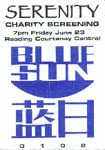 This month the local "Brown Jackets" and
house_monkey
organised the Wellington, New Zealand screening of Serenity (the movie sequel to the Firefly television series)
for charity. I got ticket 0102 (pictured) :). The charity is "Equality Now" a feminist group co-founded by Joss
Whedon's mother. Before they screened the movie there was a video clip of Meryl Streep and Joss Whedon
wherein Whedon lampooned press junkets and the inevitable question "So, Joss, why do you write such strong
female characters". His responses were brilliant and could be summed up as "Why aren't people writing MORE strong
female roles?"
This month the local "Brown Jackets" and
house_monkey
organised the Wellington, New Zealand screening of Serenity (the movie sequel to the Firefly television series)
for charity. I got ticket 0102 (pictured) :). The charity is "Equality Now" a feminist group co-founded by Joss
Whedon's mother. Before they screened the movie there was a video clip of Meryl Streep and Joss Whedon
wherein Whedon lampooned press junkets and the inevitable question "So, Joss, why do you write such strong
female characters". His responses were brilliant and could be summed up as "Why aren't people writing MORE strong
female roles?"
It got me thinking. I agreed with him. Admittedly there is a known thread of geeky guys being attracted to
strapping Amazonian women. But it is not just a question of weak guys wanting to be "mothered" - the truth is that
women ARE strong. There are many examples of female leaders - from Boudica, Elizabeth the First, Catherine the
Great, Indira Gandi and Golda Meier, right through to Helen Clark and Margaret Thatcher (though there are still
persistant rumours that Thatcher was a man). Women are physically weaker than men, but have a higher tolerence to
pain, and their second X chromosome has more genes than the male Y chromosome. So the reality is that geeks
appreciate women for what they are, while perhaps chauvanists WANT women to be something less, (as they feel
threatened by strong independant women) popular media supports this image (sells more beauty products and plastic
surgery), and women hide their light under a bushel rather than scare off a potential (chauvanist) mate.
It bugs me. Whedon is right. Why aren't there more strong women role models?
Comment
Top
May 2006
Like that painting
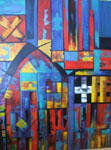 In May a friend of mine - Amanda Tomasoa had her painting exhibition "World View: Contemporary Paintings" at the
Naxos Gallery, 38 Kilbirnie Crescent. One of her works (Maximum Exploration) is to the right.
In May a friend of mine - Amanda Tomasoa had her painting exhibition "World View: Contemporary Paintings" at the
Naxos Gallery, 38 Kilbirnie Crescent. One of her works (Maximum Exploration) is to the right.
I also attended a friends wedding in Sydney - and stayed in Hurstville, south Sydney, an area full of immigrants
and with a strong Chinese feel.
Other events of the month included the manufacture of sea hexes for playing
Harpoon, seeing a few movies (including the rather inferior
X-Men: The Final Stand), assembling and painting Full Thrust
miniatures and other minor gaming projects. All in all a bitzer of a month.
Comment
Top
April 2006
Hugging the panda
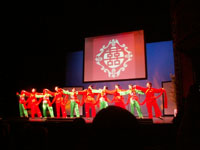 The month of April featured a lot of interesting cultural events. I attended a Chinese Double Happy show
(pictured) that featured New Zealand Chinese performers, urhu players and vignette plays about Chinese gold
miners and such. Prominant amongst the actors was Sonia Yee, who had an excellent role in
Hate Crimes.
The month of April featured a lot of interesting cultural events. I attended a Chinese Double Happy show
(pictured) that featured New Zealand Chinese performers, urhu players and vignette plays about Chinese gold
miners and such. Prominant amongst the actors was Sonia Yee, who had an excellent role in
Hate Crimes.
Peschardt's People
had an illuminating interview with Vanessa Mae, I finally got to see "Gone with the Wind" and friends
had a drunken poetry evening. This in turn gave me the opportunity to show off my
writing, and to read some of Wilfred Owen's poetry. Owen and his friend Siegfried
Sasoon both served in the British Army in WWI, and wrote some of the most amazing poetry:
Wilfred Owen - Letter to Osbert Sitwell (July 1918)
For 14 hours yesterday I was at work -
teaching Christ to lift his cross by numbers,
and how to adjust his crown;
and not to imagine he thirst till after the last halt;
I attended his Supper to see that there were no complaints;
and inspected his feet to see that they should be worthy of the nails.
I see to it he is dumb and and stands to attention before his accusers.
With a piece of silver I buy him every day,
and with maps I make him familiar with the topography of Golgotha.
Siegfried Sasoon: "The General" (April 1917):
'Good-moring, good-morning!' the General said.
When we met him last week on our way to the line.
Now the soldiers he smiled at are most of 'em dead,
And we're cursing his staff for incompetent swine.
'He's a cheery old card,' grunted Harry to Jack
As they slogged up to Arras with rifle and pack.
* * *
But he did for them both by his plan of attack.
All in all it was a very cultural month.
Comment
Top
March 2006
Kissing the void
 Spent much of this month playing a lot of Go, seeing movies,
and working. I also had a chance to watch the DVD of the TV Series
"Firefly" by Joss Whedon.
Spent much of this month playing a lot of Go, seeing movies,
and working. I also had a chance to watch the DVD of the TV Series
"Firefly" by Joss Whedon.
For those of us who can remember back to the early days of Classic Traveller, there was a ship called the
Empress Marava Far Trader. It had two decks, a large cargo bay with loading ramp, and a communal dining
hall where passengers ate with the crew. Typically with Traveller, the crew themselves were a bunch of
misfits and oddities.
Now this has all come to life - bless Whedon (creator of Buffy and Angel) - as he has brought Traveller to
TV, and with the feature film Serenity, to the big screen
as well.
With a strong cast of nine characters, each with a significant back story, and attention to scientific
detail (ships make no noise in vacuum and so forth) this series was a winner. Which is why Fox screened the
episodes out of sequence, and canned the whole series after 14 episodes or so. I might be selfish, but perhaps
this was a good thing. The series is letter perfect, and it was over before it had a chance to lag, drag and
stretch for ideas.
The milleu chosen by Whedon is the outer colonies - the frontier - where colonies are dumped on newly terraformed
worlds and left to fend for themselves. The frontier - with backward communities scraping a living, little
technology and hence transport by horses. The Captain (Malcolm Reynolds, played by Nathan Fillion) was on the
losing side of a civil war. Hence there are space ships, lazer pistols, horses, wagons, and lots of drinking in
saloons - science fiction with a western flavour - right down to the crew which includes a preacher (Book, the
Shepard, played by Ron Glass) and a saloon whore (Inara, the Companion, played by Morena Baccarin), all played with
a twist. Given Whedon's penchant for strong characterisation, and glittering repartee, this series is a joy to
watch.
Well worth a look - in my humble opinion.
Comment
Top
February 2006
Conquer the void
 Huge interstellar wars, and massive space combats in the depths of space. That is what life is all about. Attack
ships on fire off the shoulder of Orion, C-beams glittering in the dark near the Tanhauser Gate. Jon M Tuffley and
friends have produced an excellent set of space combat rules called "Full Thrust". February marked the beginning
of a friend's Full Thrust Campaign, and the illustration at right is of a Von Tegettoff dreadnaught and escort in
orbit above the world Indus IV.
Huge interstellar wars, and massive space combats in the depths of space. That is what life is all about. Attack
ships on fire off the shoulder of Orion, C-beams glittering in the dark near the Tanhauser Gate. Jon M Tuffley and
friends have produced an excellent set of space combat rules called "Full Thrust". February marked the beginning
of a friend's Full Thrust Campaign, and the illustration at right is of a Von Tegettoff dreadnaught and escort in
orbit above the world Indus IV.
One of the values of science fiction is its glimpse into how we may lead our lives in the future.
Arthur C Clarke,
Robert Heinlein,
Isaac Asmiov,
Jerry Pournelle, and
Philip K Dick,
are or were all science fiction writers. They are also (respectively) the inventor of the telecommunications
satellite, an aerospace engineer, a chemist, the 20th centuries most important futurist (IMHO) and one of our
greatest anti-utopian visionaries.
Reality is for those who can't deal with wargames, science fiction and roleplaying games. :)
Comment
Top
January 2006
Catching the cat
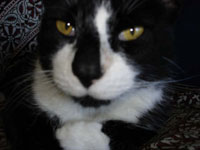 Time for a revamp. I have reworked my personal website and added this blog (out with the old, in with the
new...). The past two years in Wellington have been brilliant. I have become acquainted with Podcasting -
Where experts in their field produce a digital broadcast that you receive, not by radio, but by downloading
it from the web. The best I have found has been This Week in Tech (TWiT) hosted by Leo Laporte, and available
from
www.twit.tv.
This podcast is at the centre of a group of spinoff podcasts such as Security Now and Inside the Net.
One of the major personalities on TWiT is John C Dvorak, and it would not be right to blog about TWiT without
mentioning Dvorak's blog at
www.dvorak.org/blog =)
Time for a revamp. I have reworked my personal website and added this blog (out with the old, in with the
new...). The past two years in Wellington have been brilliant. I have become acquainted with Podcasting -
Where experts in their field produce a digital broadcast that you receive, not by radio, but by downloading
it from the web. The best I have found has been This Week in Tech (TWiT) hosted by Leo Laporte, and available
from
www.twit.tv.
This podcast is at the centre of a group of spinoff podcasts such as Security Now and Inside the Net.
One of the major personalities on TWiT is John C Dvorak, and it would not be right to blog about TWiT without
mentioning Dvorak's blog at
www.dvorak.org/blog =)
I got a cat from a local cat shelter - Max. And I have been fooling about with various hobbies and computing
projects at home. Max has been helping - as I make plaster coated wargaming scenery, he has been stepping
in them and adding paw prints. Priceless!
Comment
Top
Christmas 2005
Chasing the cat
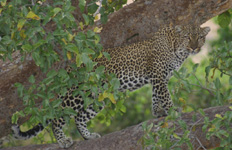 Friends of mine, Sean and Diana, work for the UN. Sean does networking and Diana does web design (Diana taught
me some of the basics of web design). Currently they are working in Burundi, and taking tourist trips all round
Africa - to places like Manyara, Ongorongoro, Amboselie, Zanzibar,
Lake Nakuru
and
Maasai Mara.
By all accounts it is hard to find the elusive leopard, and only by following a trail of dead gazelles stashed in
trees (a sort of leopard larder) were they able to find and finally photograph a leopard. Hence when this news
arrived at Christmas, Sean and Diana offered up an new rendition of the 12 days of Christmas, ending not with a
"Partridge in a Pear Tree", but instead a "Leopard in a Fig Tree".
Friends of mine, Sean and Diana, work for the UN. Sean does networking and Diana does web design (Diana taught
me some of the basics of web design). Currently they are working in Burundi, and taking tourist trips all round
Africa - to places like Manyara, Ongorongoro, Amboselie, Zanzibar,
Lake Nakuru
and
Maasai Mara.
By all accounts it is hard to find the elusive leopard, and only by following a trail of dead gazelles stashed in
trees (a sort of leopard larder) were they able to find and finally photograph a leopard. Hence when this news
arrived at Christmas, Sean and Diana offered up an new rendition of the 12 days of Christmas, ending not with a
"Partridge in a Pear Tree", but instead a "Leopard in a Fig Tree".
Comment
Top
November 2005
Sinking the boat
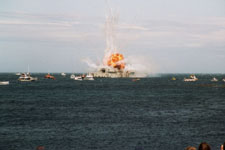 On November 13, 2005 HMNZS Wellington was sunk several hundred yards off the southern Wellington coastline.
I wanted to see it, but got stuck in traffic. Fortunately a friend of mine got to see the whole thing, and took
this photograph - as the explosives went off in the belly of the frigate, fireworks were triggered on top of the
ship's bridge (pictured). This broad-beam Leander, originally named the HMS Buchante, served in the Iceland Cod
War, and in the Falklands. More of her story, and information on diving on her wreck is available
here.
On November 13, 2005 HMNZS Wellington was sunk several hundred yards off the southern Wellington coastline.
I wanted to see it, but got stuck in traffic. Fortunately a friend of mine got to see the whole thing, and took
this photograph - as the explosives went off in the belly of the frigate, fireworks were triggered on top of the
ship's bridge (pictured). This broad-beam Leander, originally named the HMS Buchante, served in the Iceland Cod
War, and in the Falklands. More of her story, and information on diving on her wreck is available
here.
Comment
Top
October 2005
Standing stones
 This month I splashed out and bought the DVD
"Spring Summer Autumn Winter and Spring" a Korean movie covering the life story of a monk, interwoven with
zen buddhist philosophy. A very slow, quiet and beautiful movie. It reminds me of one of my favourite quotes
from comedienne Lily Tomlin: "The problem wih the rat race is, even if you win, you are still a rat." So this
month was a little more philosophical than most, and also (at the suggestion of my friend Grant) it involved
visiting
Stonehenge Aotearoa.
This monolithic site is the brain child of Richard Hall and the
Phoenix Astronomical Society. Erected with a
grant from the New Zealand Royal Society, this stone circle has been designed to display the use of ancient
stone circles as calendars and astronomical observatories. In addition to a visit to the circle, there is
a talk and slideshow on paleoastronomy - the study of how the ancients studied the stars. This place is well
worth a look!
This month I splashed out and bought the DVD
"Spring Summer Autumn Winter and Spring" a Korean movie covering the life story of a monk, interwoven with
zen buddhist philosophy. A very slow, quiet and beautiful movie. It reminds me of one of my favourite quotes
from comedienne Lily Tomlin: "The problem wih the rat race is, even if you win, you are still a rat." So this
month was a little more philosophical than most, and also (at the suggestion of my friend Grant) it involved
visiting
Stonehenge Aotearoa.
This monolithic site is the brain child of Richard Hall and the
Phoenix Astronomical Society. Erected with a
grant from the New Zealand Royal Society, this stone circle has been designed to display the use of ancient
stone circles as calendars and astronomical observatories. In addition to a visit to the circle, there is
a talk and slideshow on paleoastronomy - the study of how the ancients studied the stars. This place is well
worth a look!
Comment
Top
May 2005
Flying through the sky
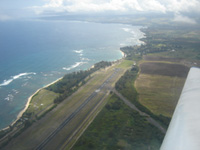 In May 2005, my brother went gliding in Hawaii (he is learning to be a glider pilot). It is possible to take
guided flights at Dillingham
air base, which is in the north west corner of Oahu Island. The site is used for gliders during the day, but
apparently USAF aircraft land there at night. Adjacent to the runway are old overgrown revetments dating back
to World War Two, and a diagonal side road leads to the site of an old Nike SAM missile battery.
In May 2005, my brother went gliding in Hawaii (he is learning to be a glider pilot). It is possible to take
guided flights at Dillingham
air base, which is in the north west corner of Oahu Island. The site is used for gliders during the day, but
apparently USAF aircraft land there at night. Adjacent to the runway are old overgrown revetments dating back
to World War Two, and a diagonal side road leads to the site of an old Nike SAM missile battery.
Comment
Top
April 2005
Watching the sky
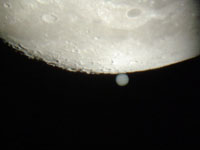 On April 23 there was a conjunction of Jupiter and the Moon - where the two celestial objects were almost in line.
The angle between the moon and Jupiter was only 0.6 degrees. Apparently the two objects only pass this close once
every 75 years. This happened again on May 20, where the separation between the two bodies was only 0.4 degrees.
(Because of the orbits of the moon and Jupiter, it is possible for two conjunctions to occur in two sequential
months - presumably because Jupiter is either stationary in the sky or has started into the
retrograde part of its orbit). I found the photo shown
on a local website, and I think this is of the May conjunction. I hope the person who put it up doesn't mind me
using it. If you look closely you can see the banding of Jupiter's cloud tops.
On April 23 there was a conjunction of Jupiter and the Moon - where the two celestial objects were almost in line.
The angle between the moon and Jupiter was only 0.6 degrees. Apparently the two objects only pass this close once
every 75 years. This happened again on May 20, where the separation between the two bodies was only 0.4 degrees.
(Because of the orbits of the moon and Jupiter, it is possible for two conjunctions to occur in two sequential
months - presumably because Jupiter is either stationary in the sky or has started into the
retrograde part of its orbit). I found the photo shown
on a local website, and I think this is of the May conjunction. I hope the person who put it up doesn't mind me
using it. If you look closely you can see the banding of Jupiter's cloud tops.
Comment
Top
Wellington 2003
Buying land
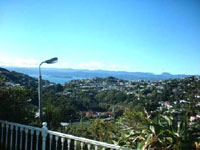 Took up a new post as a systems programmer on A-Series mainframes (yay big iron!) in Wellington, and bought
a small place with a sea view. It was covered in gorse, so as an escape from my desk job, had an enjoyable
workout cutting gorse, trimming gorse, carting gorse, pulling gorse stumps, and seeding grass. Magical!
Jane decided not to follow me down and we signed marriage dissolution papers in September 2005.
Took up a new post as a systems programmer on A-Series mainframes (yay big iron!) in Wellington, and bought
a small place with a sea view. It was covered in gorse, so as an escape from my desk job, had an enjoyable
workout cutting gorse, trimming gorse, carting gorse, pulling gorse stumps, and seeding grass. Magical!
Jane decided not to follow me down and we signed marriage dissolution papers in September 2005.
Comment
Top
Auckland 1995
A career in computing
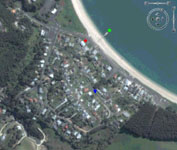 After leaving the university system I got a job back in Auckland selling scientific equipment for a while.
Then I did technical writing, until I landed a job in the IT industry as a mainframe computer operator. Lousy
hours, but quite good pay. Performed poetry live for a year or two for fun, publishing in
"Tongue In Your Ear"
and did voluntary work teaching science and maths to the "Tampa" Afghan Refugees. Spent a couple of years
living on the beach at Maraetai, and even got married. Pictured: I first lived at Maraetai at the blue dot, then
at the red dot. We were married at the green dot, and the reception was at the red dot.
After leaving the university system I got a job back in Auckland selling scientific equipment for a while.
Then I did technical writing, until I landed a job in the IT industry as a mainframe computer operator. Lousy
hours, but quite good pay. Performed poetry live for a year or two for fun, publishing in
"Tongue In Your Ear"
and did voluntary work teaching science and maths to the "Tampa" Afghan Refugees. Spent a couple of years
living on the beach at Maraetai, and even got married. Pictured: I first lived at Maraetai at the blue dot, then
at the red dot. We were married at the green dot, and the reception was at the red dot.
Comment
Top
Palmerson North 1984
A career in science
After graduating, I got a job helping teach genetics at
Massey University
in Palmerston North. Made some excellent friends, and then did a master's degree (my thesis was on wine yeast).
Received a
NASA
scholarship to study at
Woods Hole Oceanographic Institute in the United States, and around this
time got my first email account. In 1992 I started my PhD, but this did not go well. In addition I was learning
more and more about the net, discovering UNIX "Talkers" - social websites like
Foothills
and becoming ever more interested in this form of distributed social computing (i.e. The Internet). Finally quit
the doctorate when I could see that there was no career at the end of it. By this stage I figured out I had
received about six scholarships of one type or another.
Comment
Top
Early stuff
Getting there from here
This is where it begins I suppose. I am an "air force brat" - with a great uncle who navigated
Lancaster
bombers over Berlin in World War II; About 54 acres of family land lies under the grass airstrip of
Whenuapai
Airforce Base, and my father, one uncle and a number of friends have served with the RNZAF. I was born near
Ohakea Airforce Base
during the
October Missile Crisis (1962).
A nomal childhood of games and pets and teenage angst. Drew comic books to entertain my family and friends, and
went to school with the comic book artist
Dylan Horrocks.
I have always been interested in science, computers, machines and such, and read science fiction voraciously as
an adolescent. In 1983 I completed a bachelors degree with a double major in cell biology and zoology at
Auckland University.
Comment
Top

